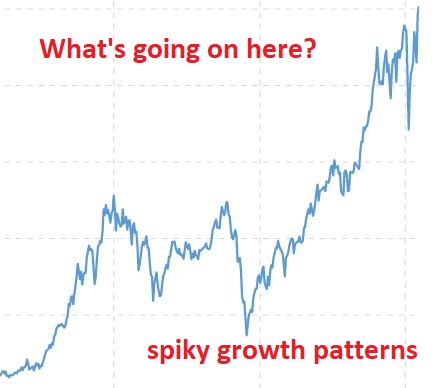How Many Backlinks Per Month?
Join the 1,000+ brands that trust us for their link building.
How many backlinks should you build in a given month? This is a common concern among new website owners or those who are just getting into link building.
It’s a very logical question to consider when building out a website. Everyone knows that inbound links are essential for website growth and performance. I’m assuming that you’re aware of this fact as well since you’re reading this article.
It also takes time for web pages to get indexed by Google so planning on a monthly basis makes sense.
Moreover, the whole idea of a backlink growth rate has been a revolving topic of discussion within the SEO community for years, and the theory is still relevant today.
Link Velocity (Growth Rate)
Link velocity is a catchphrase that describes the concept of a backlink growth rate, or how fast a site generates new inbound links (e.g. how many backlinks per month).
In other words, link velocity is something like the speed of link growth for a page or domain. It’s the rate at which other sites (i.e. referring domains/pages) are linking to yours.
The whole subject of link velocity has been debated within the SEO community for quite some time, highlighting the reality that there isn’t a definitive answer to the question of how many links per month is safe.
Everyone looks to Google for answers, since it’s their algorithms that SEOs are most concerned about, but even Google won’t give a clear-cut response.
This lack of consensus has forced people to conduct trial and error experiments and ad hoc analyses to form their own conclusions, which for the most part have delivered very useful results to the community.
Today we have a better understanding of link velocity’s effect on website performance, and there are generally accepted principles and best practices that can guide inexperienced site owners.
This article is going to discuss the popular ideas surrounding link velocity, and whether Google cares about link velocity in terms of ranking, as well as explain what makes a good backlink and how quality is better than quantity.
You’re also going to learn how to build backlinks to your site at a safe speed per month and what to look out for in case you decide to speed up your link building process.

How Do Backlinks Affect Ranking?
Backlinks can have a positive or negative effect on rankings depending on how they’re obtained. The effect can be quite substantial, regardless of whether they benefit or harm your site because backlinks are the most important SEO ranking factor.
There is plenty of independent research that confirms the relationship between backlinks, organic traffic, and ranking in the SERPs. For example, search traffic increases for most websites as the number of referring domains increases (if the ranking effect is positive).
Because not all backlinks are created equal, sometimes more backlinks can actually lower the rank of a site. This negative rank movement is usually due to Google’s detection of poor quality backlinks, a pattern of unnatural link building, or a rapid influx of links associated with a newly established domain.
Some Research On Backlinks and Ranking
There have been empirical studies by SEO professionals like Ahrefs that have examined how backlinks are related to search traffic and ranking position.
A brief summary of the findings is as follows:
There is a strong positive relationship between the average number of “followed referring domains” (backlinks) for top-ranking sites and their organic search traffic.
The top 3 ranked pages for any given SERP usually acquire the most new backlinks over a period of time compared to the rest of the pages. They simply receive more total backlinks on average.
On average, the higher a site is ranked in a given SERP the faster it grows its backlink profile. The #1 ranking page tends to have the highest rate of link growth over time (it’s hard to catch up to the top sites).
Finally, there isn’t a clear relationship between the relative change in a page’s backlink profile (compared to the SERP) and the change in the page’s ranking position.
This last observation is very interesting because it implies that link growth does not necessarily improve rankings. This is because not all backlinks are created equal (quality vs quantity).
So these studies show that backlinks and ranking are definitely related to each other. One possible explanation for these types of results is that top-ranking pages get more exposure and credibility (i.e. trust) than lower ranked pages.
This exposure creates a feedback loop whereby the top pages naturally acquire more backlinks (i.e. they get referred to more often) which in turn increases traffic and keeps them at the top positions in the SERPs.
Now let’s discuss one thing that most top-ranked sites have in common: quality link profiles.
What Makes a Good Link?
We will keep this section short and sweet because we have plenty of informational resources you can check out to learn more about what makes a good link.
If I had to wrap the idea in a neat little package, I would describe a good link as a contextual link with relevant anchor text from an authoritative, trustworthy website that’s pointing to an inner page on your site (the most natural place for relevant information).
This type of link would appear relevant, authoritative, and natural. It doesn’t describe every single type of high quality link, but it covers most of the bases and is a safe and effective link to build into your profile.
If I had to dive deeper into the anatomy of a good link, I would emphasize the link’s most important ranking factors: authority, power, and relevance. What we call the Holy Trinity. Make sure your links have these qualities in varying degrees.
Authority
The authority of a backlink refers to the overall domain authority of the website it’s linking from. A website gains domain authority as it receives more high quality links that point to all its pages from many diverse referring domains (link diversity). It’s a signal that many people trust the domain and refer traffic to it.
Power
The power of a backlink comes from how many high quality links are pointing to the page the backlink is coming from. So it’s similar to domain authority but refers to a specific page instead of a whole website.
Relevance
Relevance is determined by how relevant the content and on-page optimization (i.e. keywords, anchor text, metadata) of the website/page that’s sending the backlink is compared to the content and keywords of the receiving site. Try to get links from related sites, especially within a niche. It’s really just common sense.
Link Diversity
Ultimately your site’s collection of inbound links will comprise your backlink profile, which is the overall footprint that Google algorithms pay a lot of attention to when they decide to reward or penalize a website.
The goal should be to maintain a quality link profile that looks natural and comprises different types of backlinks from different sources, including links that possess the Holy Trinity factors described above.
This link building strategy, along with other factors, is called link diversity. This is really a brief explanation, so we suggest that you learn more about link diversity by reading our related articles.
Now let’s get into the nitty-gritty: quality versus quantity.

Quality vs Quantity
Although Google doesn’t like to divulge a lot of information about its algorithms, it will share some handy guidelines every now and then. One of the most valuable pieces of guidance they’ve given to the SEO community is “backlinks should come naturally, along with the content on your site.”
What Google is implying with this statement is that quality is far more important than quantity when it comes to ranking. Any activity that looks unnatural should be avoided. You will get a better grasp of the idea of natural versus unnatural as you continue reading.
If you consider that quantity is related to link velocity, then Google’s statement is also saying that quality is more important than the speed of link acquisition.
Does Link Velocity Really Matter?
So what does Google actually think about link velocity’s effect on rankings? Well, there has been some evidence to support that Google actually pays attention to abnormal growth patterns and not link velocity per se (depending on the situation).
Link velocity is actually a catchphrase created by the SEO community to make link building sound quantitative in nature and also raise alarms about getting too many backlinks per month, generally speaking.
The concept of link velocity may not even have a concrete definition from the point of view of Google’s algorithms. However, a spiky growth rate or big sudden increases in backlinks will raise red flags and could be analyzed for any shady tactics that might be causing such unusual behavior.
Your ranking will suffer the consequences if any shady tactics were indeed used and detected by search engine algorithms.
Moreover, evidence from a Google patent also suggests that a high rate of link growth could perhaps benefit a website’s ranking score more than another site that has a lower rate of growth. This would actually contradict the idea that high link velocity is bad.
The insight to draw from all this confusion is that link velocity is good or bad depending on the situation. A website’s growth pattern over time is a better indicator of naturalness depending on certain conditions surrounding the cause of the site’s link growth.
The conditions that may cause excessive or unnatural-looking link growth could simply be that the website’s topicality (i.e. freshness of content) and relevance has increased. In other words, the website’s content has gone viral because of trending topics. This will increase linking and organic traffic.
Google is fair and its algorithms will credit your website if it suddenly acquires a bunch of new incoming links due to the aforementioned reasons, even if that would appear totally unnatural under normal circumstances.

Should You Just Avoid Quantity To Be Safe?
No, of course not. The number of backlinks you eventually get still matters for ranking. You shouldn’t hinder a successful site from growing and acquiring more backlinks over time.
Your website can receive a significant increase in the number of new links per month or several months, and continue to perform well in the SERPs if that increase is associated with quality content.
Google expects increases in backlinks to come with an increase in quality content (because it’s natural for good content to be linked to more often).
High quality backlinks and content will allow you to increase quantity while minimizing red flags. And maintaining high quality over time is safer than blindly increasing link acquisition with no regard for best practices.
Also, keep in mind that older and more established domains with lots of preexisting backlinks can safely acquire more links without drawing penalties compared to a brand new site without many links. This is just part of the complexity of ranking.
Older domains could have more authority, trust, and organic traffic than newer websites. Also, relative growth is a more meaningful signal than absolute growth. A large website with thousands of existing backlinks could acquire 100 new inbound links in a month and this would only represent a small percentage of growth in the overall link profile.
On the other hand, if a new website with only 10 backlinks decided to add another 20 links in the first month of operation, that would represent a sudden growth rate of 200%. This is an example of a spiky and possibly unnatural growth pattern that you shouldn’t replicate too often when building links.
If those 20 new links don’t appear to be high quality backlinks, or if they clearly weren’t earned naturally (e.g. spammy auto-generated links), then you can expect your ranking ability to be negatively affected.
Final Thoughts on Quality vs Quantity
Just remember that quantity won’t always benefit you in the long run if it isn’t backed up with quality backlinks. There are countless examples of sites with fewer backlinks outranking sites with more.
Safe link building strategies will shield you from penalties and ensure that you’re maintaining natural link profiles.
Another way to answer the question of quality versus quantity is to see what your competitors are doing. Competitor analysis is a big part of SEO and is very useful in many situations.
Just look up the top 10 competitors in your niche and see how many links they’ve gained over time and where those links are coming from. This information could provide you with a good starting point for your link building strategy, especially during the first few months of site operation.
So now you should have a solid understanding of the importance of quality over quantity. With this foundation of knowledge, you can start building out your site. Let’s touch again on the concept of link velocity and discuss how fast you can start acquiring backlinks in a given month.
How Fast Can You Send Backlinks to a Site?
You understand that quality is more important than quantity. So the real question is how fast can you generate quality links in a given time period, such as a month.
Nobody knows what a site’s “optimal growth rate” should be, so don’t spend too much time trying to determine an exact figure. To be honest, you shouldn’t have to worry about link velocity if you’re building truly quality links on a regular basis (Google will eventually acknowledge the quality and reward you for it).
A website’s optimal growth rate really just depends on how old the site is, how many existing links it contains, and how natural its link profile is (and other factors which are outside the scope of this article).
You should remember that Google has a very good sense of when spammy, unnatural link building strategies may have been used (such as when a site acquires 1,000 new backlinks in a day).
Google sees huge spikes in link acquisition in a relatively short period of time, which aren’t justified by topical trends or going viral or indexing/ranking, as a potential case of shady tactics.
In most cases, a natural growth pattern (for traffic or referring domains/pages) is one that looks like a steadily increasing curve over a long period of time. Avoid unnatural-looking spikes.
You can confirm this by exploring the top-performing sites for a given keyword. You will notice this growth shape in many cases.

A Simple Guide for Gradual Growth
You can follow this simple strategy if you’re inexperienced and just starting a new website.
Start off slow with pillow links in the first month. Establish some presence through social media, profile creation, forums, etc. Use relevant natural anchors whenever linking back to one of your inner pages. A few guest posts or niche edits in the first month are okay too.
We aren’t going to give you precise numbers. Instead, we encourage you to perform site analysis of your competitors. Try to mimic the growth patterns of successful websites. You’re going to notice a trend of gradual growth over time.
Natural-looking growth could look something like this:
First month: 10 backlinks to your homepage (granted it’s a new site without much content)
Second month: 12 backlinks to your homepage
Third month: 15 backlinks to mostly your homepage
Fourth month: 20 backlinks, 3/4 going to your homepage
Fifth month: 20 backlinks, 1/2 going to inner pages
Sixth month: 30 backlink, 1/2 going to inner pages
It’s not inventing the wheel and shouldn’t have to be. Link building isn’t an exact science with mechanical equations.
Keep in mind that these monthly growth rates may seem relatively high because it’s a brand new site and you should be actively trying to acquire new links. The rate of acquisition will likely slow down after some time.
The safe and systematic way to grow is to periodically increase quality links each month, but not by too much relative to how many total backlinks you currently have. Start out slow and build up naturally. Make sure to always maintain link diversity.
You can conduct ad hoc experiments or perform competitor analysis if you want to really get quantitative about strategy development.
Some Final Thoughts
A safe and smart link building strategy will increase quality backlinks naturally over time. For example, publish quality content and the links will come.
You want your site to have a natural-looking growth pattern each month, like a gentle upward curve. Avoid unnatural spikes in traffic (unless you discover how to grow content from trees).
This is the common sense art of link building in the world of SEO, which is less about scientific rigor and quantitative analysis, and more about what looks natural.
Also, remember that a website with 5,000 referring domains can safely acquire a lot more new links than a site with 50 referring domains. It’s all about relative growth.
From our experience, it seems that a brand new website, or a site with a low amount of backlinks, tends to get penalized more for increasing its inbound links too quickly. But this drop in ranking is usually temporary and easily resolvable by an experienced SEO.
Google won’t give you the answers to their equations so be smart, vigilant, and stick to safe techniques. The only real way to measure your success is by constantly monitoring your site and analyzing your performance in relation to your competitors.
Issues That Can Occur If You Send Too Many Links in a Month
There isn’t too much to be said about this that hasn’t already been covered. If you acquire too many backlinks in a month then you may incur some ranking penalties from Google, or nothing will happen at all.
Remember, the whole concept of link velocity is subjective and depends on the situation. There aren’t many precise answers — only generally accepted principles and proven methods of safe link building.
The biggest issue when you build links too fast in a month is that your website may suffer a temporary drop in search traffic or ranking. Nothing is really permanent and opportunities to correct mistakes and improve your rankings will be available.
Sometimes it takes time for sites to pass Google’s checkpoints and eventually rank (there are so many factors involved in ranking). Link velocity is not the sole limiting factor.
Other issues that can occur with rapid link growth may not have anything to do with the actual growth itself, but more about the lack of quality displayed by incoming links. You may be getting lazy and irresponsible with your link building activities.
Sometimes you can get so caught up in building links that you make mistakes and engage in risky behavior. This would be a personal issue that needs to be addressed by you or your team.
There are plenty of general issues that can arise if your website starts to suffer in the SERPs. Maybe your business revenue or even reputation will be at stake if your site is continually penalized in ranking.
But more often than not, if you’re building quality links with natural methods, then any drop in search traffic or ranking will be temporary. You’ll be able to resolve any issues and get back on track.
How Many Backlinks Per Month Wrap-Up
It’s normal to want to boost your page rankings as fast as possible, and acquiring backlinks is the best way to do it. But any smart and experienced SEO should know that quantity won’t improve performance in the long run without quality to back it up.
There are lots of factors that determine the optimal growth rate of a website’s backlink profile, yet nobody really knows with certainty how to fit all the pieces together in a tidy package. There isn’t a concrete number of backlinks you should acquire per month because that’s not exactly what the algorithms look for.
You need to look at the big picture and focus on getting quality links as fast as it can safely and reasonably be done.
Avoid irregular growth patterns during any given month unless you can truly back it up with good authoritative links and quality content. Instead, the safe path is to aim for natural and steady growth each month (slow and steady wins the race). It takes time for pages to get indexed so planning on a monthly basis is a good idea.
Most top performing sites exhibit a pattern of steady growth over time without unusual spikes.
Our own experiments as well as studies by other SEOs have generally shown that, on average, top-ranking pages tend to acquire backlinks at a higher rate than lower-ranked pages. But link growth isn’t necessarily associated with improved rankings.
This leads to the final conclusion that quality is more important than quantity or link velocity. Make sure to build links that are tied to relevant and useful content. This is the safest and most natural method of building links each month.
Contributing Author: Brian Kihneman
 Article by:
Article by:
Nicholas Altimore
Hey I'm Nick, the Founder/Director here at SirLinksalot. I have a passion for building online businesses and taking websites to the next level with the help of my amazing link building team.
 Questions or Comments?
Questions or Comments?
We are active in our Facebook Group seven days a week and would love to hear from you. Ask us questions, learn from other group members, and share your knowledge.
Related Posts
Ready To Start Building Your Rankings?
Your link building journey to the top of Google starts today!
Apply for Managed Link Building to get a free analysis and game plan, or order backlinks a la carte.
Link building services that work.


